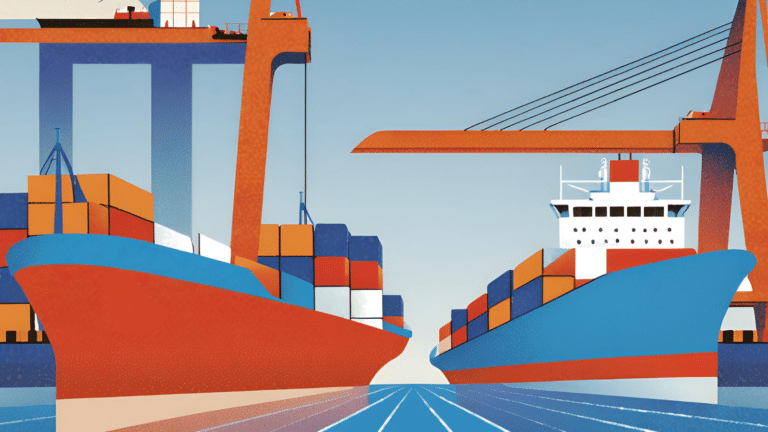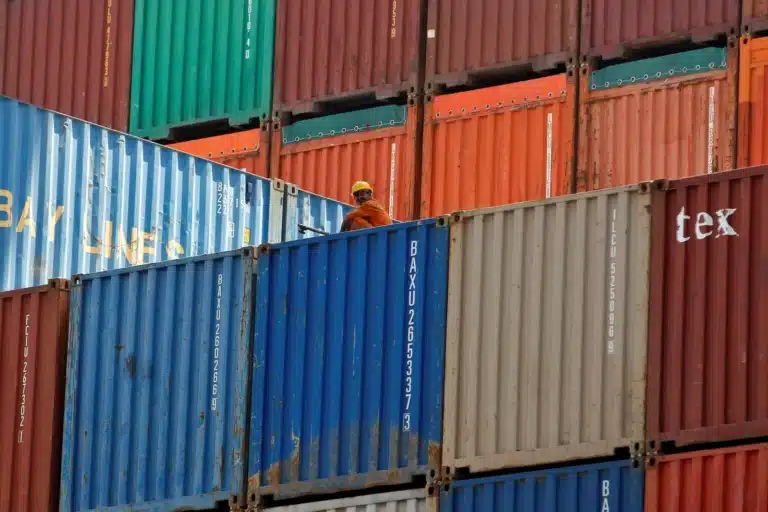How a US-China trade war puts the Middle East in a bind
Analysis: The Middle East may be caught in the crossfire of a US-China trade war, navigating economic uncertainty without wanting to pick a side.
For the latest updates on access to the Morningside campus, visit the Public Safety website. Read more.
Insights from the Center on Global Energy Policy
President Trump has agreed to a 30-day pause on proposed 25 percent tariffs on Canada and Mexico. There are many moving parts to the action but for now the implementation has been delayed to allow more talks with Ottawa and Mexico City. However, the 10 percent tariffs on China have taken effect and Beijing has responded with tariffs on US energy imports, export controls on tungsten and other critical minerals, and an antitrust probe into Google.
After promising such tariffs on the campaign trail, Trump has ascribed multiple goals to them—from bringing manufacturing back to the United States and raising government revenue to reducing trade deficits and giving Washington negotiating leverage. While Trump used tariffs in his first term, the next 30 days may set the path for the next four years. One possibility is that the tariff threat to Canada and Mexico is simply building leverage for a renegotiation of the United States-Mexico-Canada Agreement (USMCA). However, it is also possible that Trump will follow through on the across-the-board tariffs after the 30-day pause. This approach would upend decades-long integration in North American trade, particularly around energy, resources, and manufacturing, and raising sovereignty challenges for Canada and Mexico. Meanwhile, the China track in which Trump described his initial actions as an “opening salvo” risks further tensions in an already fraught bilateral relationship. Energy is particularly sensitive from the perspective of US economic and security goals, as indicated by the Trump decision to limit energy tariffs to 10 percent for Canada versus the broader 25 percent.
The proposed specific use of emergency powers by President Trump to justify tariffs will also raise further risks around US economic statecraft as a means to influence not just US adversaries, but now – perhaps– friends and trading partners as well.
President Trump has positioned border security broadly, and the fentanyl crisis specifically, as justification for using the International Emergency Economic Powers Act (IEEPA) to announce tariffs on an expedited basis without a protracted administrative procedure. Actions by the Canadian and Mexican governments to address the fentanyl issue have put the tariffs on hold for now, but Trump has not yet ended the declaration of a national emergency and by extension, the tariffs. Canada and Mexico had already announced some measures while disputing the full nature of Trump’s accusations about their respective roles in the fentanyl trade. Trump has still not specified any concrete actions that Canada, Mexico, or China could take that would result in removing the tariffs although these will likely be the focus of negotiations in the next 30 days.
There is also a separate process looking more broadly at unfair trading practices among US trading partners that is scheduled to conclude by April 1. This suggests more tariffs are possible even if further actions on the border and the fentanyl crisis are taken. This could include the introduction of more “durable” tariffs under Section 232 or Section 301, as well as a rollover of negotiations into the USMCA review that is due by 2026. The case that Trump is seeking long-term tariffs is also reinforced by his stated objective to raise revenue from tariffs to fund tax cuts, and from a recognition that short-term term tariffs will be insufficient to reroute supply chains and drive relocation of manufacturing and capital investment back to the United States. Trump appears to measure success with multiple metrics, but one measure seems to be reindustrialization – measured by the announcement of new US factories, smelters, refineries, steelworks, and timber mills that are either being built or relocated because of his tariffs and economic policies.
If the proposed tariffs move forward, Canadian energy exports will be subject to a 10 percent, rather than 25 percent tariff. Mexico’s 450,000 barrel per day (bpd) crude exports to the United States face the 25 percent tariff rate. The concession to Canada, which supplied 60 percent of US oil imports or 4 million bpd of crude in 2024, is noteworthy as it seems to signal that affordability concerns remain on the Trump agenda. A 25 percent tariff on both Canadian and Mexican imports could lead to lower US refinery runs, as many US refiners depend on the extra-heavy sour crude imported from Canada in particular and would face higher input costs with the tariff. A 10 percent tariff on Canadian oil and 25 percent on Mexican oil is likely to have a less material impact for US consumers, but if the tariffs ended up being more permanent, they could impact refinery margins and capacity utilization in the US refinery system.
Meanwhile, Canadian officials will likely continue to advocate for a deeper energy relationship, seeking to align the deeply integrated US-Canada energy trade as a key enabling factor of US energy dominance. Gas and electricity will also be subject to the 10 percent tariff although the United States arguably has greater ability to absorb higher costs of supply in these areas than it does in oil as electricity exports from Canada equal about 1 percent of US consumption. Nonetheless, Canada could make the case that its gas and electricity exports can help meet growing US demand driven by data centers and AI. Short-term disruptions of Canadian electricity exports to the US West Coast and Northeastern states would be significantly disruptive but difficult to implement because of the potential for US retaliation and the operational challenges related to grid stability on both sides of the border.
Canada was reportedly considering an export tax on energy exports as retaliation to the US tariffs. Such a proposal would seek to pressure the Trump administration by further increasing costs for US energy consumers while generating revenue for the Canadian government to use to offset the broader economic effects of the tariffs. Export taxes are not part of the first round of retaliation and could trigger greater tensions with the Trump administration and escalation, as well as provoking strong opposition from oil producing provinces in Western Canada.
Mexico lacks a comparable option to use energy to retaliate against the US tariffs, as it imports 70 percent of its natural gas consumption from the United States with similar dependence on US refined product importsto meet Mexican demand needs.
There was some speculation that the 25 percent tariff on Canada might exclude certain critical materials such as aluminum and nickel, but as of this writing that does not appear to be the case. Similar to Canadian heavy oil, the supply of Canadian nickel and aluminum will not be easy to replace from US domestic or international sources. Both nickel and aluminum are on the US Critical Minerals List. Based on 2023 trade data, Canada supplies about 50 percent of US nickel and 60 percent of imported aluminum. Particularly in the case of nickel, there is little domestic capacity available in the United States to pick up the slack. Alternative suppliers like Indonesia could supply more to the United States with Canadian exports being redirected elsewhere to avoid the tariff, but other strategic suppliers like China and Russia face separate tariffs and/or sanctions with the United States and cannot fill the void.
China in particular is already in a standoff with the United States over critical minerals, as evidenced by its recent restrictions on rare earth exports and the ‘Three G’s” of germanium, gallium, and graphite. Trump’s tariffs on Canadian and Mexican minerals imports would have arguably weakened the US ability to reduce existing dependencies on Chinese supply chains and effectively compromise efforts such as the Minerals Security Partnership. The decision to move forward with tariffs on US crude oil. LNG, coal, and further restrictions on rare earths exports targets US energy dominance ambitions and potential vulnerabilities around critical mineral supply chains. For now, these measures are calibrated but could escalate further.
The headline 10 percent tariff on China is lower than Canada and Mexico, but China has already been subjected to a range of tariffs that began in the first Trump administration and continued under President Biden. The China tariffs represent a very different dynamic than Canada and Mexico both because of broader tensions in the US-China relationship and because China’s larger economy and more diversified trade are less vulnerable to US actions.
The counter-tariffs and sanctions announced by China are relatively measured and seem to leave room for negotiation—and, if talks fail, escalation. Mindful of its own domestic economic slowdown, China may initially seek to avoid inflaming bilateral tensions with the new Trump administration, which has thus far struck a less hawkish tone on China than many expected. Relative to Canada and Mexico, China has a large domestic market, a global network of trading relationships, significant fiscal capacity and reserves to weather the storm. While its initial raft of retaliatory measures was restrained, they hinted that China could retaliate asymmetrically if tensions escalate, including by sanctioning individual US companies and imposing export controls on critical minerals. Targeting Google for anti-trust action, while mostly symbolic, is further evidence that the technology sector is likely to remain a key point of tension as both countries pursue global leadership in areas such as artificial intelligence and semiconductors. China possesses significant retaliatory capacity, and over time could strike back aggressively against the United States if Beijing deems it necessary.
The Canada-Mexico tariffs, if they proceed as proposed after the 30-day delay, would be the latest instance of the rising use of economic statecraft by both Democrat and Republican administrations in Washington, although Trump’s proposed use of emergency powers to impose across-the-board tariffs while shunning traditional administrative procedures marks a major shift. The move would be another step toward weaponizing America’s central role in the global financial system, value chains, and as an export market as tools to try to influence the policies of other countries. Over the past twenty years, these efforts have been concentrated on a growing list of US adversaries, including Iran, Russia, China, North Korea, and Venezuela. The proposed use of IEEPA, the statute that underpins American sanctions programs, against Canada and Mexico represents an escalation and expansion of US economic statecraft, given that the targets are close US partners and the breadth of the tariff action and its blunt imposition in spite of the existing USMCA relationship.
It would be at a minimum a stretch of rules-based trade actions and could lower confidence among other US trading partners that they can rely on existing trade frameworks to protect their interests. Because it is unprecedented to use IEEPA for tariffs, the harm likely to be felt by US consumers and certain business sectors, and the questionable nature of labeling Canada a national security threat, the tariffs will likely face legal challenges and could end up being enjoined.
As discussed, Canada and Mexico have a limited option set in responding to the prospective Trump tariffs by diversifying to other markets. Trump has also signaled hostility to Chinese investment in Mexico and Canada which limits optionality on that front. Nonetheless, one option for Canada and Mexico is to try to find new markets for their energy, materials, and manufactured goods where they can, including in the EU, India, and Asia-Pacific. But given the logistical challenges and sheer scale of integration with the US, these would likely be decade-long efforts.
Lastly, Trump has talked about a broader reframing of North American political relations that go well beyond trade, not just vis-à-vis Canada and Mexico, but also in his comments about Greenland and Panama. While the current tariffs may ultimately just be about Trump seeking a better deal within existing structures like the USMCA, he may also envision a new and more US-dominated geopolitical vision for North America, in which the trade, security, and border decisions are driven by Washington. If that is the case, the challenges for Canada and Mexico in maintaining sovereignty and control of their destinies may just be beginning. In this uncertain context, Ottawa and Mexico City will likely remain focused on diversifying trade, broadening their networks of allies, and strengthening internal competitiveness.
On February 4, the Trump administration imposed an additional 10 percent tariff on all Chinese imports into the United States. China’s Ministry of Commerce responded by announcing new tariffs on US imports,...

The sweeping new sanctions imposed on Russia’s energy sector by the Biden administration on January 10 mark a significant shift in strategy. Since the start of Russia’s full-scale...

This year’s Conference of the Parties (COP-29) broke new ground with the Baku Initiative for Climate Finance, Investment, and Trade (BICFIT)—the first high-profile COP initiative to place trade...

Economic statecraft, and sanctions in particular, are popular policy instruments because they promise to deliver leverage at someone else’s expense. Sanctions can create pressure by taking away something...

This commentary addresses the importance of Indonesian nickel supply to US climate goals, and why a US-Indonesia critical minerals agreement could be beneficial for both countries.

Over the past 25 years, the United States and India have deepened their cooperation, transforming a relationship that was once defined by estrangement and tension.

To counter China’s cleantech dominance without hampering the energy transition, the United States needs to expand its circle of friends.
